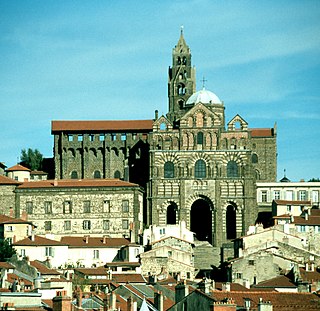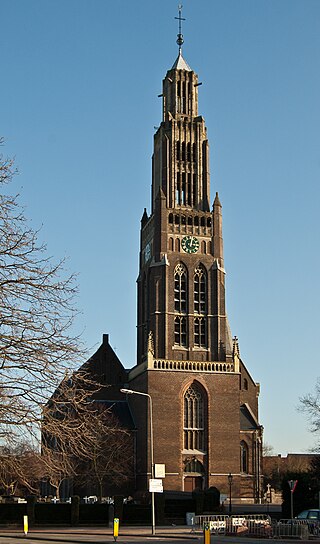
Simpelveld is a municipality and a town in the southeastern Netherlands. It is part of the municipal cooperative unit Parkstad Limburg.

The Basilica di Santa Maria Gloriosa dei Frari, commonly abbreviated to the Frari, is a church located in the Campo dei Frari at the heart of the San Polo district of Venice, Italy. It is the largest church in the city and it has the status of a minor basilica. The church is dedicated to the Assumption of Mary.

St. Salvator's Cathedral is the Roman Catholic cathedral of Bruges, Belgium. The cathedral is dedicated to the Verrezen Zaligmaker and Saint-Donatius of Reims.

The Cathedral of St. Michael and St. Gudula, usually shortened to the Cathedral of St. Gudula or St. Gudula by locals, is a medieval Roman Catholic cathedral in central Brussels, Belgium. It is dedicated to Saint Michael and Saint Gudula, the patron saints of the City of Brussels, and is considered to be one of the finest examples of Brabantine Gothic architecture.

The Catholic Cathedral Church of St. John (Sint-Janskathedraal) of 's-Hertogenbosch, North Brabant, is the height of Gothic architecture in the Netherlands. It has an extensive and richly decorated interior, and serves as the cathedral for the bishopric of 's-Hertogenbosch.

The Catholic Church in the Netherlands is part of the worldwide Catholic Church under the spiritual leadership of the Pope in Rome. Its primate is the Metropolitan Archbishop of Utrecht, currently Willem Jacobus Eijk since 2008. In 2015 Catholicism was the single largest religion of the Netherlands, forming some 23% of the Dutch people, based on in-depth interviewing, down from 40% in the 1960s.

Bocholtz (Dutch pronunciation: [ˈbɔxɔlts]; Ripuarian: Bóches[ˈbʊχəs] is a town in the Dutch province of Limburg. It is a part of the municipality of Simpelveld, and lies about 7 km southwest of Kerkrade. Until 1982, it was a separate municipality.

Dreischor is a village in the Dutch province of Zeeland. It is a part of the municipality of Schouwen-Duiveland, and lies about 20 km southwest of Hellevoetsluis.

Bordeaux Cathedral, officially known as the Primatial Cathedral of St Andrew of Bordeaux, is a Catholic church dedicated to Saint Andrew and located in Bordeaux, France. It is the seat of the Archbishop of Bordeaux.

Le Puy Cathedral is a Roman Catholic church located in Le Puy-en-Velay, Auvergne, France. The cathedral is a national monument. It has been a centre of pilgrimage in its own right since before the time of Charlemagne, as well as being a stopover on the pilgrimage route to Santiago de Compostela. Since 1998 it has been part of a multi-location UNESCO World Heritage Site along France's Santiago pilgrimage routes. It is the seat of the Bishop of Le Puy.

The Saint Remigius Church is a Roman Catholic church building in Simpelveld, The Netherlands. It is a neoroman cross shaped church with three naves, a tower with a waisted top, and a round apse. It is completely made up out of Kunradersteen, a local variant of chalk. The building is used as parish church for the local Saint Remigius parish. Patron saint for the church is Saint Remigius. Due to the inventory of the church, it has been listed as a rijksmonument, making it a national heritage site of the Netherlands.

St. Andrew’s Church is a Catholic church in Antwerp built in the 16th century. Its exterior is mainly characterised by a late-Gothic style while its interior is predominantly executed in Baroque style. It is the parish church of the Parish of St. Andrew’s. During the nineteenth century the St. Andrew's Parish was known as the parish of misery as it was by then mainly populated by poor people.

The Saint Bernard Church is a Roman Catholic church building in Ubachsberg, Voerendaal, Netherlands. Patron saint for the church is Bernard of Clairvaux. The church is a national monument of the Netherlands.

The hermitage at Schaelsberg is a monumental hermitage in Schin op Geul, in the municipality of Valkenburg aan de Geul, Netherlands. Built in 1688 for the lords of nearby Schaloen Castle, the chapel and attached living space, housed a succession of 16 hermits from its foundation until 1930. The chapel and nearby stations of the cross, added in 1843, are a national monument. Since 1758 a yearly procession, the Sjaasbergergank, is held to the hermitage, and this procession is listed as national intangible cultural heritage. Located in a tourist area of South Limburg, it is a popular tourist attraction.

The Crosier Monastery or Monastery of the Crutched Friars is a former monastery of the Order of the Holy Cross in Maastricht, Netherlands. The well-preserved convent buildings house a five-star hotel, the Kruisherenhotel. Having survived more or less in its entirety, it is a rare example in the Netherlands of a Gothic monastery. The buildings from the 15th and 16th century constitute three listed buildings (Rijksmonuments). The more or less intact monastery archive is unique in the Netherlands.

The Heuvelse kerk is a neo-Gothic Catholic church in the center of the Dutch city Tilburg. Dedicated to Saint Joseph, it is one of two major Catholic churches in the city center together with the Heikese kerk. It is located along the square Heuvel, after which it is named. A 1921 statue of the Sacred Heart is located in front of the building.

The Jheronimus Bosch Art Center is located in the former New St. James Church on Jeroen Boschplein in 's-Hertogenbosch, the capital of North Brabant. Since 2007, there has been a permanent retrospective exhibition here on the life and work of the painter Jheronimus Bosch, who was born in the town. The venue is also used for concerts and conferences.

Sint-Landricuskerk is the Roman Catholic parish church of Echt, dedicated to Saint Landry of Soignies.

The Onze Lieve-Vrouwekapel in Echt is a 17-century chapel in Schilberg, a hamlet between Pey and Echt in the Dutch province of Limburg. The chapel was declared a national monument. It is a pilgrimage site for the celebration of the Nativity of Mary.





















